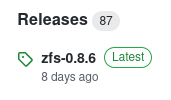Hi everyone,
I spend the last week setting up a few ZFS pools for storage. I have a mirrored pool in my PC for storage as well as a striped pool of the same size in a remote PC for backing everything up.
I am currently looking into the best way to backup my pools content to the backup pool.
I have seen in Aaron Toponce blog that ZFS offers a send and a receive command and I could do something like:
# zfs send pool/dataset@tuesday | ssh [email protected] "zfs receive pool/backup"
However as far as I see it these commands are completely agnostic of what data is already on the backup server.
# zfs send pool/dataset@wednesday | ssh [email protected] "zfs receive pool/backup"
Doing the above with a snapshot following after that one from tuesday would not only transmit the delta, meaning the changes between the two snapshots, but the complete data in the pool again, right?
What do you all see as the best way to backup a ZFS pool incrementally? Maybe I should better use a dedicated cross-platform backup software like restic?

